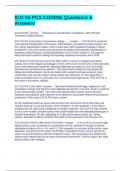ICD-10-PCS CODING Questions &
Answers
ICD-10-PCS - answer International Classification of Diseases, 10th Revision,
Procedure Coding System
ICD-10-PCS is the future of procedure coding! 🔬 - answer ICD-10-PCS stands for
International Classification of Diseases, 10th Revision, Procedure Coding System. It's
the coding classification system used to track and report inpatient (hospital) medical
procedures. This new system was developed to replace International Classification of
Diseases, Ninth Revision, Clinical Modification (ICD-9-CM), Volume 3, Procedures,
which had been used for coding and reporting inpatient procedures since 1979.
ICD-10-PCS is the hot new kid on the block when it comes to inpatient procedure
coding. One of the biggest advantages of ICD-10-PCS over ICD-9-CM is that it provides
much more detail and specificity, allowing healthcare providers to more accurately
describe the procedures they perform. This extra level of detail not only helps with
billing and reimbursement, but it also helps with research and data analysis, since
researchers can use the codes to track trends and outcomes. It's like going from a
black-and-white movie to a full-color, 4K, surround sound experience - ICD-10-PCS is
the future of procedure coding! 🔬
ICD-10-PCS is the future - answer Because medical terminology, diagnoses, and
procedures change and become more detailed and specific over time, there's a need for
a new classification system. The ICD-9-CM classification system quickly became
obsolete and outdated, and it became more difficult to accurately reflect the procedures
performed. That's why ICD-10-PCS was created.
As the healthcare field has grown and evolved, the old-school ICD-9-CM codes just
couldn't keep up. It was like trying to drive a Model T on the Autobahn - it just wasn't
designed for the speed and complexity of modern medicine. ICD-10-PCS was created
to be a more modern, flexible system that could handle the ever-changing landscape of
medical procedures. It's like upgrading to a high-performance sports car - faster,
sleeker, and able to take on anything the road (or the operating room) throws at it.
ICD-10-PCS STRUCTURE AND FEATURES - answer ICD-10-PCS is a seven-digit
alphanumeric code consisting of a combination of the numerals 0 through 9 and the
alphabetical letters of A-H, J-N, and P-Z. (For example, for excision of the tonsils, open
approach, the ICD-10-PCS code is 0CTP0ZZ.) The letters O and I aren't used in the
system to avoid confusion with the numbers 0 and 1. The procedures are divided into
sections and categorized by the type of procedure performed. The first digit in the code
always reflects the category.
, The seven-digit alphanumeric structure of ICD-10-PCS codes makes them more
complex than the simple three- to five-digit numeric ICD-9-CM codes, but that
complexity allows for greater precision and specificity. Each digit in the code represents
a different component of the procedure, including things like the body system, the
approach, the device used, and the qualifier. For example, the first digit of 0CTP0ZZ
indicates that the procedure was performed on the "head and neck," while the "0" in the
second digit indicates that it was an "excision." The remaining digits provide even more
detail, like the specific body part involved (tonsils) and the approach used (open). It's a
little like a medical Sudoku puzzle, where each digit must fit in just the right spot to
make the whole code make sense!
The ICD-10-PCS code sections are as follows: - answer 0: Medical and Surgical
• 1: Obstetrics
• 2: Placement
• 3: Administration
• 4: Measurement and Monitoring
• 5: Extracorporeal Assistance and Performance
• 6: Extracorporeal Therapies
• 7: Osteopathic
• 8: Other Procedures
• 9: Chiropractic
• B: Imaging
• C: Nuclear Medicine
• D: Radiation Oncology
• F: Physical Rehabilitation and Diagnostic Audiology
• G: Mental Health
• H: Substance Abuse Treatment
ICD-10-PCS codes are divided into 17 main sections, which cover all the major body
systems and procedures. Here are the main sections:
- 0: General procedures (e.g., ventilation, blood transfusion, dialysis)
- 1: Operations on the nervous system (e.g., brain surgery, spinal cord procedures)
- 2: Operations on the eye and adnexa (e.g., cataract removal, glaucoma surgery)
- 3: Operations on the ear (e.g., hearing aid placement, ear tube insertion)
- 4: Operations on the respiratory system (e.g., tracheotomy, lung biopsy)
- 5: Operations on the circulatory system (e.g., heart bypass surgery, angioplasty)
- 6: Operations on the digestive system (e.g., appendectomy, gastric bypass surgery)
main sections of ICD-10-PCS. - answer that's a good summary of the main sections
of ICD-10-PCS. I'd just add that there are also sub-sections under each of these main
sections, which provide even more specific detail about the procedures being coded.
For example, under "Medical and Surgical" there are sub-sections for things like
"Anesthesia," "Surgical Drainage," and "Surgical Repair." The sub-sections help to
further clarify the exact procedure that was performed, which is important for accurate
coding and reimbursement. It's kind of like Russian nesting dolls - the more you dig into
the code sections, the more specific it gets!




